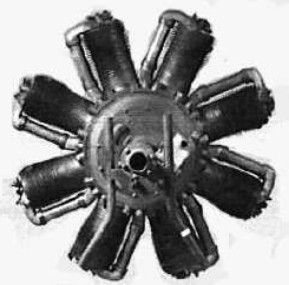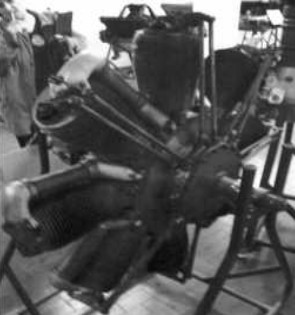Updated: 28-Apr-2020
It is the "Ladetto-Ubertalli e Cavalchini-Torino-". They made a rotary engine cataloged as experimental from the year 1912. It gave 80 CV and had a 6-stroke cycle.

“Luct, 80 CV”
-Torino company (see FIMA as well).

“Un Luct en el Polito”
-In 1912 there was the presentation of the 7-cylinder, 60/65 CV rotary engine that ran with a 6-stroke cycle.
-The 1913 the 7-cylinder rotary "B", gave 50 CV at 1,200 rpm.
-The "C" model was of the same year and gave 80 CV. It was a 9-cylinder rotary.
-The "E" engine also appeared in 1913. It gave 80 CV with 7 cylinders.
-And the "F" model came out the same year 1913, giving 100 CV with 9 rotary cylinders.
-A description of the LUCT engine working with the 6-cycle system, received from the Polytechnic of Torino, in Italian, literally says:
-“Una delle poche ditte che negli anni Dieci produceva motori a stella fu la torinese Luct (Ladetto, Ubertalli e Cavalchini, Torino) che progettó vari tipi di propulsori a sette, otto e nove cilindri.
-A seguito della liquidazione dell’azienda, la produzione venne proseguita dalla Fima di Torino.
-Al I Concorso militare italiano di Aviazione,tenutosi a Torino presso il campo di Mirafi ori nellàprile del 1913, fra gli esemplari che superanono le prove di qualificazione, vi fu un modello stellare rotativo Luct con potenza di 80 CV.
-Tale motore era a sei tempi: aspirazione miscela, compressione, esplosione con espansione, scarico, aspirazione aria di lavaggio, espulsione aria di lavaggio. In occasione del Concorso del 1913 il motore venne montato su un monoplano Nieuport -Wolsit. Il Luct 80 CV non superó mai la fase sperimentale”.
Translation:
- “One of the few companies that produced radial engines in the 1910s was the Turin-based Luct (Ladetto, Ubertalli and Cavalchini, Turin) which designed various types of seven, eight and nine cylinder engines.
-After the company's liquidation, production was continued by Fima of Turin.
- At the first Italian Air Force Competition, held in Turin at the Mirafi ori field, April 1913, among the specimens that passed the qualification tests, there was a Luct rotary radial model with a power of 80 HP.
-This engine was six-stroke: mixture suction, compression, explosion with expansion, exhaust, washing air suction, washing air expulsion. On the occasion of the 1913 competition, the engine was mounted on a Nieuport-Wolsit monoplane. The Luct 80 CV never passed the experimental phase ".
End translation
-The two additional strokes (suction and sweep expulsion -lavaggio-) what they did was to clean the cylinder from gases from the previous working stroke. Thus, they achieved that the engine ran cooler.
Engines of LUCT
Model: Model B, 7 cyl. rotary
Arquitecture: 7-cylinder Rotary
Cooling: Air
Total Displacement:
Bore / Stroke:
Power: 50 CV @ 1200 rpm
Weight:
Model: Model C, 9 cyl. rotary
Arquitecture: 9-cylinder Rotary
Cooling:
Total Displacement:
Bore / Stroke:
Power: 80 CV
Weight:
Model: Model E, 7 cyl. rotary
Arquitecture: 7-cylinder Rotary
Cooling:
Total Displacement:
Bore / Stroke:
Power: 80 CV
Weight:
Model: Model F, 9 cyl. rotary
Arquitecture: 9-cylinder Rotary
Cooling: Air
Total Displacement:
Bore / Stroke:
Power: 100 CV
Weight:
Model: Rotary 7 cyl. 60/65 HP 6-stroke
Arquitecture: 7-cylinder Rotary
Cooling: Air
Total Displacement:
Bore / Stroke:
Power: 65 CV
Weight:
Model: Rotary 8 cyl. 80 HP
Arquitecture: 8-cylinder Rotary
Cooling: Air
Total Displacement:
Bore / Stroke:
Power: 80 CV
Weight:

"Luct 8 cyl rotary, 80 CV"


